Helping get Upper Hunter producers back on track
Producer: Richard and Fiona Hordern
Property: “Canema”
Location: Kerrabee, NSW
Property size: 936 hectares
Enterprise: beef cattle
Hordern’s flood story
Hunter Valley beef producers, Fiona and Richard Hordern have called the Upper Hunter home for a long time, but rarely have they experienced a series of flood events like those that impacted their property, “Canema” during 2022.
Located in an alluvial valley close to the Goulburn River, “Canema” was flooded during March, July and September in 2022, restricting access to paddocks with continual waterlogging and saturation of the soil, suppressing pasture quality and setting back farm production and livestock operations.
“Fortunately, our country is not low-lying enough that paddocks were completely inundated for long periods, but a fair percentage of our farm was affected by waterlogged soils,” Richard said. “We couldn’t access many paddocks due to the wet and we were unable to muster and sell cattle due to inaccessibility for heavy vehicles.”
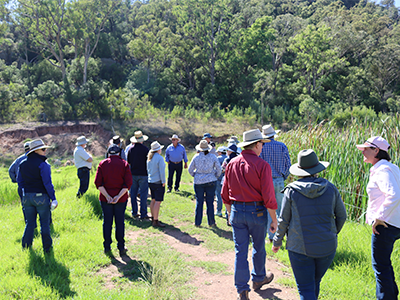
Image 1. The Local Land Services Farm Rejuvenation farm-visit tour to ‘Canema’ with host producer, Fiona Hordern on right.
Farm Rejuvenation Workshops
To support the farm recovery of the Hordern’s and many other flood-affected producers in the Denman area, Hunter Local Land Services ran a series of Farm Rejuvenation Workshops. This practical program linking producers with advisory support to get their farm businesses back on track was funded through the NSW and Australian Government’s Early Needs Recovery Program.
Hailing from Martindale, Bureen, Kerrabee and Gungal, a group of 15 producers were given access to regional recovery services and workshop sessions with local agronomist, Neil Nelson of Neil Nelson Agvice, and Local Land Services advisory staff to review their production goals and rebuild their businesses.
The series of farm visits and tailored workshops gave the Hordern’s the opportunity to assess their soil and pasture condition, through soil and feed testing, and set an action plan for their pasture program while also getting off-farm to network with neighbours and share ideas and solutions. “Each session was valuable. We learnt the importance of soil testing and choosing suitable plant species for multi-species pastures, especially with the application of the correct fertiliser,” Richard said. “We also enjoyed looking at other producers’ operations, particularly with sub-tropical pastures."
"The knowledge we gained in understanding soils and pastures and the effect of flooding/saturation was invaluable. It allowed us to put a plan together for our property.”
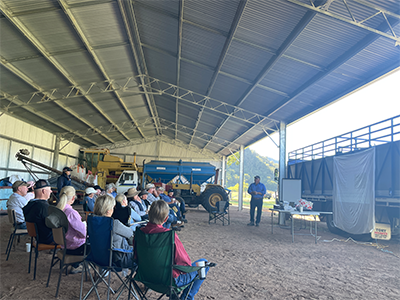
Image 2. Producers gathered on the ‘Canema’ farm tour at Kerrabee to network, share recovery journeys and discuss pasture recovery with agronomist, Neil Nelson and Local Land Services livestock officer, Teresa Hogan.
Importance of feed testing
A key part of the program was helping the producers assess and understand the nutritional value of the feed they have on farm and how this will impact their recovery. “After carrying out feed testing, we were surprised at the low quality of our cereal hay, which made us realise how much the flooding/saturation of the paddock during the growing period affected the hay,” Richard said. “We were also quite surprised with the decrease in weight gain of the younger cattle compared to previous years, some of which can be attributed to the lesser quality of flood affected pastures.”
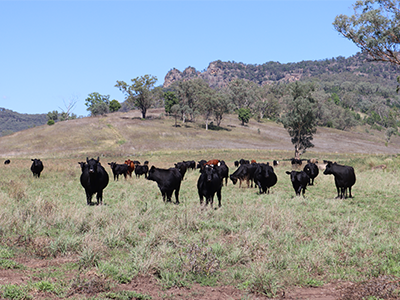
Image 3. Cattle grazing on the alluvial valley floor at ‘Canema’, Kerrabee in the Upper Hunter.
The Hordern’s hosted a popular on-farm visit for the Farm Rejuvenation group guided by Neil Nelson and Hunter Local Land Services livestock officer, Teresa Hogan where producers were able to compare the actual NSW DPI feed testing data with the hay in the shed and pastures in the paddock.
“There’s nothing like an on-farm tour to get a message across and raise awareness, and I’m sure many farmers from this group will now be requesting feed tests with bought in fodder and contacting their Local Land Services office to organise pasture or hay sampling when in doubt about stock feed quality,” Teresa said.
“Across the region last year, widespread flooding saw a flush of feed of relatively low nutritional value due to its high water-content. These standing grasses are now quite rank and growing livestock will need supplementing to meet nutritional demands. I would encourage producers to talk to their local livestock officer and get advice for their individual situation and class of livestock.”
Benefits of soil testing
As part of the Farm Rejuvenation Workshops, producers carried out soil testing on farm to get a baseline for their properties, determine limiting factors and build a plan for their property. “It was really interesting to soil test our paddock that had been cropped and fertilised and see the difference compared to the unimproved paddocks,” Richard said.
“The soil testing was really beneficial in helping us determine the most suitable fertiliser and rates to use in the future." “It also confirmed leaching in some paddocks due to waterlogging, compaction due to cattle and sustained water retention on clay type soils.”
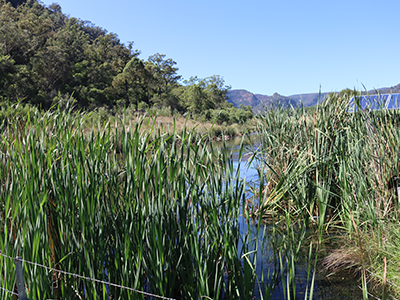
Image 4. Healthy waterhole at ‘Canema’ from which stock access is restricted and water is reticulated by solar pump to a trough system covering the property.
1:1 support and advice
“We also put our hand up to have agronomist, Neil Nelson visit us on-farm to provide one-on-one advice as part of the Farm Rejuvenation Workshops and it was fantastic,” Richard said. “Neil came and explained the soil test results and offered follow-up advice on pasture rejuvenation and establishment." “He was very aware of seasonal conditions and the cost effectiveness of suitable pasture establishment and provided a detailed written report which was invaluable to refer back to."
The role of Local Land Services in farm recovery
The Early Needs Recovery Program has been working toward providing on-ground support and services to assist primary producers regain lost productivity following the severe weather and flood events in February and March 2022. The program has achieved some great outcomes across technical and advisory services, industry tailored initiatives, landscape scale weed, pest and disease control and support for not-for-profit organisations to rebuild fences damaged by floods.
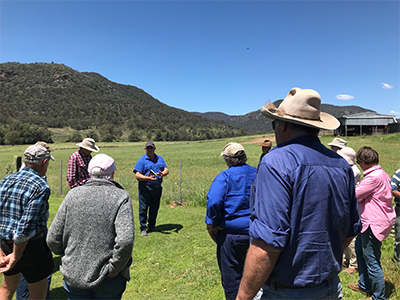
Image 5. Upper Hunter farmers talking pastures with agronomist, Neil Nelson of Neil Nelson Agvice at the Farm Rejuvenation workshop farm visit to ‘Canema’ at Kerrabee.
The Early Needs Recovery Program is part of the $150 million Primary Industry Support Package which is co-funded by the Australian and NSW Governments under the Disaster Relief Agreement.
For more information
Contact your nearest Local Land Services office on 1300 795 299 or visit the Early Needs Recovery Program.